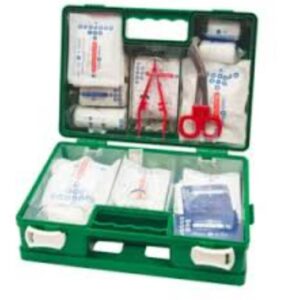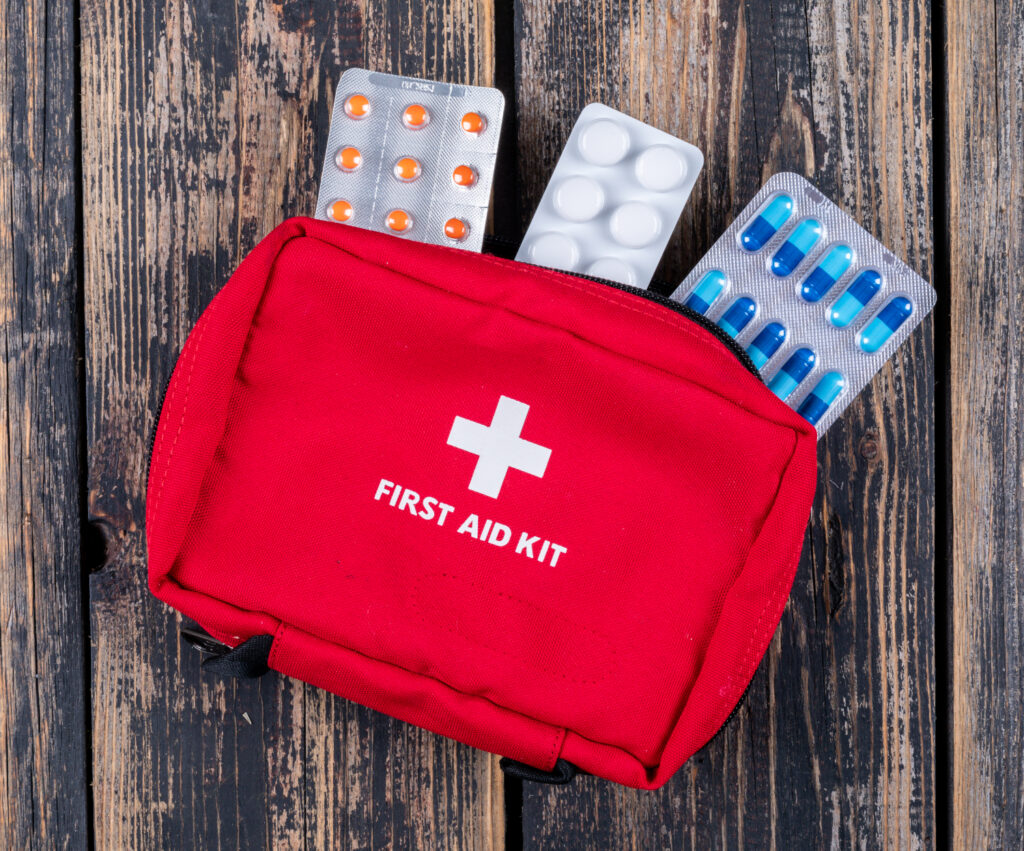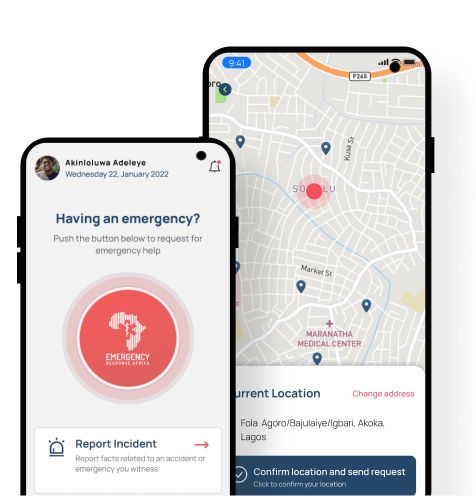The sight of a first aid box is rare in Nigeria. In workplaces, schools, and public spaces, it’s often missing, neglected, or barely stocked with the essentials. Yet, accidents, both minor and life-threatening, happen every day.
For many, first aid is an afterthought. Regulations exist, but enforcement is weak. Basic medical supplies that could stop bleeding, prevent infections, or even save lives are unavailable when they are needed most.
What does Nigerian law say about first aid boxes? What should they contain? And why do they remain out of reach in critical moments?
To understand the stakes of this neglect, it’s essential to first define what a first aid box is and why it matters in a country prone to emergencies.
What Is a First Aid Box?
A first aid box is a container that holds a collection of medical supplies and equipment designed to provide immediate or emergency treatment to a sick or injured person before professional medical help is available.
Some definitions will proceed to add that a first aid box is stored in the home, school, or workplace. This could be attributed to its weight, which means it is not easy to carry out frequently.
This raises an important question: What is the difference between a first aid box and a first aid kit?
First Aid Box vs. First Aid Kit: The Difference?

Earlier, we established that first aid boxes are typically found in fixed locations such as schools, homes, factories, and workplaces. They are accessed when injuries or sudden illnesses occur in those spaces. But what about situations where people are on the move, like hiking or camping?
In such cases, carrying a fully loaded box of medical supplies is impractical due to weight and space limitations. This is where a first aid kit comes in.
A first aid kit is a portable collection of medical supplies designed for emergency use. It is built for mobility and convenience, making it lighter and easier to carry. Unlike first aid boxes, which can hold a larger quantity of supplies, first aid kits prioritize compactness and efficiency.
So, if you see a small, handy bag containing medical essentials, that’s a first aid kit. If you come across a larger, less portable box meant for fixed locations, that’s a first aid box.
Regulations Governing First Aid in Nigeria
Nigeria’s Labour Act (1974) and Factories Act (Cap F1 LFN 2004) mandate employers to provide a safe working environment, which includes first aid provisions.
The Factories Act specifically requires employers to maintain “adequate first aid equipment” in workplaces. However, it does not define the required contents, leaving room for interpretation based on industry needs and international standards like British Standard (BS8599-1:2019) or ANSI/ISEA Z308.1.
Additionally, first aid provisions are addressed in Nigeria’s National Policy on Occupational Safety and Health (2006), which outlines guidelines for workplace safety, including the need for emergency preparedness.
Enforcement in Nigeria varies. Larger organizations and multinational companies are more likely to comply, while smaller businesses and rural workplaces often fall short due to resource constraints or lack of awareness.
Where Do You Need a First Aid Box?
Do you have children at home? If yes, you need a first aid box. No matter how careful you are, injuries and illnesses can still happen—even more so with children. I like to describe a first aid box as a “basic amenity” we need in everyday life.
You need it in schools, hospitals, workplaces, gyms, yoga classes, and religious buildings. It’s also useful in your car and, if possible, on the go. But why are these locations so critical? The answer is simple: you can never tell when and where accidents happen.
Not convinced yet? Here’s a breakdown of places where you need a first aid box and why it is very vital:
- Homes (Especially with Children): You can never be too careful with children as they are prone to scrapes, burns, or sudden fevers—accidents that can escalate without immediate care. A first aid box ensures parents can respond swiftly, whether it’s bandaging a cut or cooling a minor burn, before deciding if a doctor’s visit is needed.
- Schools: We all know how “dangerous” and prone to injury some sports can be, especially due to the poor state of fields and pitches in Nigerian schools. Aside from sports, experimenting in science labs can lead to cuts and burns too. A well-stocked first aid box can stabilize a child until parents or medics arrive, especially in rural areas where hospitals are far away.
- Workplaces: From using a stapler to big machinery, the potential for accidents at workplaces cannot be overemphasized. Even though Nigerian law mandates first aid boxes at such places, many lack them; leaving workers vulnerable to infections from injuries due to delays in getting professional care.
- Hospitals: First aid box in a Hospital? I know what you are thinking, considering the fact that the hospital is filled with medical professionals. But even hospitals need portable first aid boxes for emergencies outside treatment rooms—like a visitor fainting in a hallway or a sudden incident in the parking lot.
- Gyms and Yoga Classes: Working out with a dumbbell can be rewarding, but imagine it falls on your feet. Aww! Major physical activities such as this bring risks of injuries, dehydration, or dizziness. A first aid box can prevent minor issues from becoming major setbacks.
- Religious Buildings: While dancing to your favorite song or listening to a sermon in a tight space, fainting, heat exhaustion, or small injuries may occur. Mosques, churches, and some other traditional gatherings host large crowds, often in such conditions. A first aid box is the next call of action especially when medical help is not immediately nearby.
- Cars: Road accidents or breakdowns in remote areas can leave you stranded, sometimes for hours before reaching a clinic. A first aid box in your vehicle can stop bleeding or treat shock, buying time until help arrives.
- On the Go (Portable Kits): For travellers, hikers, or market vendors, carrying a small kit means readiness for bites, blisters, or sudden illness, especially where healthcare access is unreliable.
First aid boxes are not for design or aesthetics, they are lifelines in a country where emergency response can be slow or uneven. A first aid box turns anyone into a first responder, bridging the gap until professional help steps in.
The First Aid Box: Design and Structure

A first-aid box is not just a random container. It is a carefully designed unit, and every aspect of its design serves a purpose, making it visible, durable, and easy to use when it matters most.
The Container
A basic first aid box is usually a sturdy, lightweight plastic or metal case with a secure lid to protect its contents from dust, moisture, and damage. It is often small enough to carry (e.g., 20 cm x 15 cm x 10 cm) or store easily in a home, car, or office.
Labelling
It is marked with “First Aid” or a cross symbol for easy identification. In some cases, you will find both identifications on it.
Colours
You may have seen different colour markings on the first aid box; here are the popular ones.
Green with a White Cross
This is the most widely recognized international convention for a first aid box. It is rooted in standards from organizations like the International Organization for Standardization (ISO 7010) and the British Standard (BS8599-1:2019).
The green colour symbolizes safety and emergency aid, while the white cross is a universal first-aid identifier under ISO 7010 (symbol E003). Green helps to eliminate confusion with medical or humanitarian symbols like that of the Red Cross.
Although this standard is widely accepted internationally, it presents a unique challenge in Nigeria, where green and white are national colors.
The colour of a first aid kit should be as bright as day, and this may just explain the growing adoption of the colour red in the Nigerian context.
Red with a White Cross
What comes to your mind when you see the colour red with a white cross? The answer is simply the Red Cross.
Red is less standardized than the colour green; however, it is visible in some regions, even in Nigeria. It is often influenced by emergency medical services (EMS) or cultural associations.
Red signifies urgency, danger, or medical care (think ambulances or hospital signs), and this makes sense as it “screams” emergency at first glance. Making it a competitive substitute, especially in Nigeria.
Other Colors

You may not see these colours in Nigeria often, but for knowledge’s sake, here they are:
Silver/Metal: Unpainted or silver-coated metal boxes are practical for durability and common in industrial settings.
Blue with White cross: Rare, but occasionally used in food industries (e.g., catering) to align with blue bandages that stand out against food.
What Can Be Found in a First Aid Box In Nigeria?
Here’s a breakdown of key items commonly found in first aid boxes, their uses, and their importance in the Nigerian context:
| Item | Use | Relevance in Nigeria |
| Adhesive Bandages (Plasters) | Cover small cuts, scrapes, or blisters to prevent infection. | Common for minor injuries from daily activities like cooking or manual labor. |
| Sterile Gauze Pads | Control bleeding or dress larger wounds. | Useful for severe cuts or burns, frequent in industrial settings or kitchens. |
| Antiseptic Wipes or Solution (e.g., Hydrogen Peroxide, Alcohol) | Clean wounds to prevent infection. | Critical in Nigeria due to environmental factors like dust and heat, which increase infection risk. |
| Adhesive Tape | Secure gauze or bandages in place. | Ensures dressings stay on in humid or sweaty conditions. |
| Scissors and Tweezers | Cut bandages or remove splinters/foreign objects. | Practical for tailoring first aid to specific injuries, e.g., removing thorns in rural areas. |
| Pain Relievers (e.g., Paracetamol, Ibuprofen) | Relieve pain from headaches, minor injuries, or fever. | Widely used, though some debate exists about including oral medications due to regulatory ambiguity. |
| Cotton Wool | Apply antiseptics or clean wounds. | Affordable and widely available in Nigerian pharmacies. |
| Thermometer | Monitor body temperature for fever or heatstroke. | Vital in Nigeria’s tropical climate, where heat-related illnesses occur. |
| Gloves (Disposable) | Protect the first aider from bloodborne pathogens. | Increasingly emphasized for hygiene. |
| CPR Face Shield or Pocket Mask | Safely perform resuscitation. | Less common in basic kits but recommended for trained first aiders. |
| Instant Cold Pack | Reduce swelling from sprains or bruises. | Useful for sports injuries or accidents. |
| First Aid Manual | Guide untrained individuals in emergencies. | Essential in areas with limited first aid training. |
| Additional Items (e.g., eyewash solution, elastic bandages, antihistamines) | Address specific needs based on environment. | Useful in workplaces with chemical hazards or rural areas prone to insect bites. |
Challenges: Why Are First Aid Boxes Hard to Find in Nigeria?
First aid boxes are hard to find in Nigeria because of the following problems:
Poverty
A quick search on Jumia shows that a fully equipped first aid box costs between N40,000 and N70,000. Surprisingly, N70,000 is the minimum wage. That means someone might have to spend an entire month’s salary just to buy a first aid box. That’s hardly affordable.
The National Bureau of Statistics (NBS) reported in 2022 that 63% of Nigerians live in multidimensional poverty, meaning essentials like first aid often lose out on food or rent.
Businesses too cut corners. With the rising cost of electricity tariffs and production costs, many small firms skip safety investments to stay afloat, leaving workplaces unequipped.
Weak Supply Chains
The logistics hurdle of getting first aid boxes to where they are needed, for example, in rural communities can be a nightmare.
In 2022, Shubham Chaudhuri, the World Bank Country Director in Nigeria said that 87% of rural roads in the country are deplorable. In his words:
“We have about 200,000 km of rural roads all over Nigeria, of which 87 percent are in bad condition. That means only about 40,000km are usable.” – Shubham Chaudhuri
While this situation is better in peri-urban and urban areas, even there, stockouts are common. Try walking to the closest pharmacy around a peri-urban area to ask for a fully-equipped first aid box. You may be faced with disappointments, or the contents may not fully satisfy your needs.
Low Training and Awareness Levels
It is one thing to have a first aid box or kit; it is another thing to know how to use its contents. Proper sensitization on how to use the contents of a first aid box is essential.
The government, civil society groups, NGOs, and the private sector must contribute their quota to ensure first aid education reaches every part of the country, from school curricula to community workshops.
Organizations like the Nigerian Red Cross and Emergency Response Africa which offer internationally recognized first aid and CPR training already play a leading role in this effort.
Conclusion
A first aid box is more than a container of supplies; it’s a deliberate step toward saving lives. It’s not a luxury or a decorative item.
The Nigerian law regarding first aid, such as the Factories Act, lays a foundation, but its enforcement is weak. We need a strong collaboration between government agencies, medical professionals, and security forces to ensure every first aid box is stocked with quality essentials suited to Nigeria’s relentless challenges.
Pair this with training—equip every student, worker, and Nigerian with the skills to use these kits, and you turn ordinary citizens into first responders. This isn’t optional. In Africa’s most populous nation, where healthcare struggles with distance and affordability, the real question isn’t whether we can afford to act—it’s whether we can afford not to.



